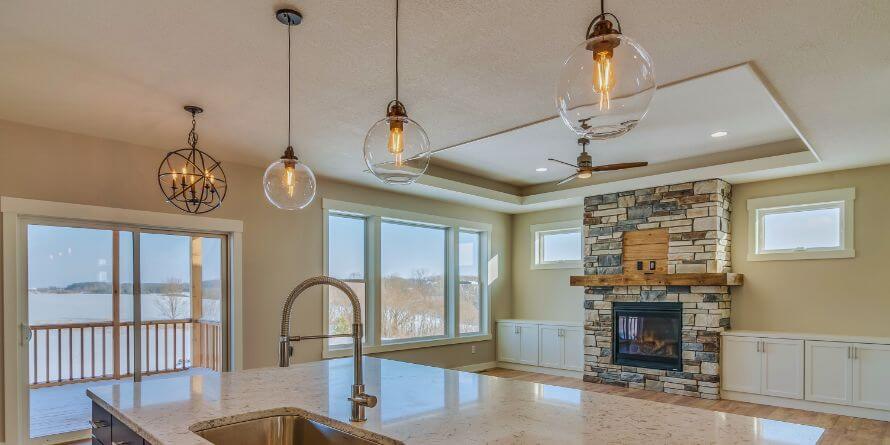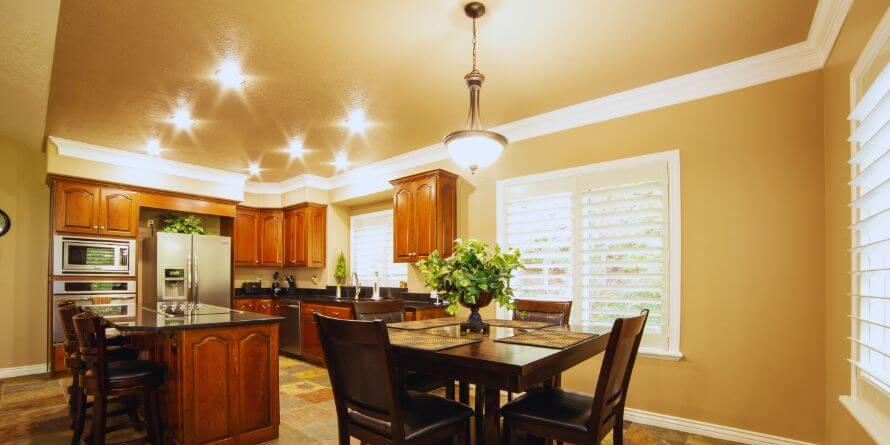One of the most important tasks to design in our kitchen is How to pair kitchen and dining lights. A beautifully light table in your home’s heart, the kitchen, transforms the dining experience from ordinary to extraordinary.
Carefully chosen lights enhance the overall ambiance and functionality of the kitchen. A connection between dining lights and kitchen design creates an aesthetic look and provides a motivational environment to try new recipes in comfortable settings.
It’s essential to understand the kitchen layout and available space flow to choose the lights accordingly, which increases the usability and beauty of the whole setting.
Good dining room and kitchen lights illuminate the entire dining area and make food preparation tasks safe. They also help in reading recipes, ensure the cleanliness of ingredients, and eliminate the chances of receiving cuts with sharp tools.
Here is a detailed guide about how to pair kitchen and dining lights.
How to Pair Kitchen and Dining Lights; Best Generative Idea for Your Kitchen
Explore kitchen dining lights ideas, the installation process, and everything that you need to know about the perfect pairing and lighting selection.
Diverse light types are available in the market, but accurate selection can be challenging for some users. The ideal combination of available choices creates a practical and beautiful kitchen.
Understanding Your Space in the Kitchen
Before you explore kitchen and dining lighting ideas, you should be aware of flow analysis. Flow analysis between the kitchen and dining room is a valuable strategy for kitchen and dining lighting ideas.
An individual should assess the distance between the dining room and kitchen to see if they are closely attached or have distinct separations.
The traffic pattern assessment is also crucial to identify the movable areas that help to illuminate the navigation corners. Natural light integration plays a vital role in selection.
A person should examine how much natural light passes through the kitchen and dining space and the total duration of this exposure. Using fixtures for spaces near the window helps diffuse or reflect the sunlight beautifully.
Functionality assessment helps choose adjustable lights in both areas that can create moods, from bright to soft and intimate.
Tips for Pairing Kitchen and Dining Lights
These things you must consider when designing your kitchen. If you feel overwhelmed, please use the so many styles, sizes of the lights.
- Size and layout
- Lighting atmosphere
- Various heights
Lighting Fundamentals for Connected Spaces
The significant challenge in connected spaces is how to place lighting in a kitchen. Considering all functionality and style principles is essential to make installations attractive. Before installing the lights, it is crucial to analyze the performable tasks under them.
Work areas like sinks, countertops, and the kitchen should be well-illuminated. Installing under-cabinet lights, task lights, or pendant lights is beneficial in this area. Adjusting the lights at points reduces shadows and makes them safe for food preparation.
Matching kitchen and dining room lighting is an attractive way to make an aesthetic combination. Selecting fixtures to complement both areas is a good idea; for example,
a matching dining room chandelier with a kitchen pendant helps to match both spaces. Combining three light layers of task, ambient, and accent provides a versatile look to the kitchen.
The light temperature should also be considered while selecting; warmer lights with 2700K to 3000K are suitable in the dining room to create a cozy and warm environment, whereas kitchen lights must be cool.
Coordinating Island and Dining Room Lighting
Practicality and design balance are the challenges when placing Kitchen island pendant lights. The rule of thumb is to hang these lights 30 to 36 inches above the island, ensuring proper brightness during food preparation.
One light is enough for a short island, but if it is significantly extended, multiple pendants with even space are better. This helps distribute light on all surfaces and makes the area safe for kitchen tasks.
Matching lighting sets are more innovative and create an eye-catching look. Selecting standard design fixtures creates an appealing look in the dining room and kitchen. So if you want more matching lights for kitchen and dining room, please visit here.
The same design and color can look odd; instead, picking a complementary color and style to match both Ambiences is preferable. The dining room chandelier or island pendant should be proportionate; extra small or excessively large creates an outdated look.
The dining light should have enough space for a convenient conversation and dinner without overcrowding. This coordinating island and dining room lighting will fit perfectly if the size is well.

Selecting the Perfect Fixtures
The most intriguing question for every organizer is how to choose kitchen light fixtures. During selection, an individual should consider the overall kitchen theme, whether traditional, industrial, or modern.
Additionally, it is necessary to consider each corner’s functionality specifications; fixing track lights, pendants, or under-cabinet lights in task-oriented places is more beneficial.
Deciding on the Best pendant lights for kitchen areas is challenging, but some basic principles can guide designers to perfect choices.
Organizers should choose a combination of style and practicality. The selection of adjustable height made of easy-to-maintain material pendants is ideal to prevent grease and stains.
Pairing Chandeliers and pendant lights provides an impressive environment. The combination of stunning chandeliers with pendant lights in matching finishes creates a visual connection between the dining area and the kitchen.
Kitchen light sets simplify the matching process by providing different fixtures with complementary designs and colors to create a perfect canvas.
Design Harmony Guide
Kitchen dining light ideas start by estimating each fixture’s functionality and style contribution. For example, pendants are ideal for hanging on the island, and chandeliers serve as a dining focal point.
Organizers should use under-cabinet lights, wall sconces, and stylish lights. Matching kitchen and dining room lights is a cutting-edge way to create a flow between these interconnected spaces.
The selection of identical fixtures is not ideal, but all fixtures should share some manufacturing elements such as color, material, and minor style matching.
Lighting collections for kitchen spaces provide easy organization of all the fixing points. These collections have island pendants, matching chandeliers for dining, and other complementary lights to fix in the kitchen or navigate areas.
Style coordination techniques, such as choosing a color palette or choosing light material according to the kitchen theme, enhance visual appeal.
Technical Installation Guide
There are several steps that an individual should know to learn how to wire a dining room light. The process starts by turning off the circuit breaker power to ensure the safe handling of electrical components.
Next, remove the previous fixture and install the new light by connecting black, white, and ground wires. Before fixing, the electrician should ensure that the selected one is compatible with the circuit and has available wattage.
The new light must easily connect with nearby switches to turn on or off without hassle. Deciding between professional and DIY options depends on one’s preferences;
If an individual has enough experience to handle electrical tasks, then DIY proves cost-effective, but the safest option is professional.
Style and Collection Tips
Choosing a combination of Lights for the dining room and kitchen has several benefits if the choices artistically complement each other. It is not essential to match all elements of the fixture.
Instead, a single one can also enhance the overall visibility. Versatile kitchen and dining lighting styles give a customized choice according to personal taste and functionality requirements.
Lights with simple and clean lines suit contemporary themes, whereas metal polish with geometric designs enhances modern decisions.
Classic designs are manufactured for traditional spaces, and an industrial ambiance can become catchy by fixing exposed bulbs, unfinished wood designs, or metal material.
Some of the Lights for Dining Room and Kitchen
There are many pendant lights in the kitchen island and dining room. Which are the modern kitchen pendant lights over the island, and also the ceiling lights for the room. Such as, a Black chandelier, traditional, and flush mount.
- DLLT Flush Mount Ceiling Light
- KAISITE Modern Chandelier Dining Room Light
- Kitchen Light Fixtures, Adjustable Semi Flush Mount
- Depuley Farmhouse Chandelier for Dining Room
- Flush Mount Ceiling Light Fixtures

FAQs
Do kitchen and dining lights need to match?
It’s not compulsory to match the entire format. Still, a slight coordination of colour, material, or design improves overall visibility and creates harmony between both spaces that looks attractive and provides seamless navigation.
Do all light fixtures in a house have to match?
Matching all the house’s lights is not essential and looks like an outdated trend. However, matching lights for kitchen and dining room with a single thread, such as colour or design, provides a balanced look throughout the house.
Can you mix lighting styles in a house?
Using versatile designs in lights creates a personalized, attractive, harmonious view of the house. Combining all fixtures allows one to design the house according to personal preferences, which looks trendy and unique.
Should you hang one or two lights over a dining table?
The final selection depends on the table size and the individual’s preferences. A single light is enough for a smaller table, but if the table is large, evenly spaced two lights are preferable.
Final Analysis
That’s how to pair kitchen and dining lights. Careful and intelligent coordination of kitchen and dining rooms adds additional attraction in both areas and increases their functionality.
However, an individual should make an informed decision by assessing the kitchen layout and overall functional preferences. Considering technical considerations and following safety guidelines are also important when installing new fixtures.
It helps in the safe handling and long-lasting functionality of lights. Thoughtfully combining the kitchen and dining room lights expresses an individual’s taste; therefore, decisions should be made after a detailed evaluation.

